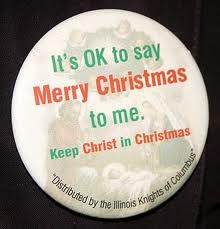Since Advent is here, I thought I would simply celebrate some of the things that make it great to be Catholic (and to promote a little evangelization as well.)
 Believe it or not, the word ‘holiday’ is Catholic. Of course it is MUCH better to say ‘Merry Christmas.’ But what kills me is that even this seemingly sanitized, ‘inoffensive’ greeting cannot escape its Catholic roots! No one escapes the influence of the Catholic Church, because the word ‘holiday’ comes from the Old English ‘holy day.’ My favorite story about this whole matter of greeting people during the Christmas season has to do with an English fellow named Sir Thomas Massey Massey. As you may know, the word ‘Christmas’ actually means ‘Christ’s Mass’, since other holidays (holy days, remember!) were named that way in England. Candlemas is the Feast of the Purification on February 2nd, and so on. Well, when England became Anglican there was this very strange idea that went around in the nineteenth century that the Catholic Mass was idolatrous. So a member of Parliament (our guy, Thomas Massey Massey) made a motion to change the name of Christmas to ‘Christ Tide.’ You know what happened? An Irishman (probably a fightin’ Irishman distantly related to Bill Donohue) seconded the motion adding an amendment, that the name of the honorable Sir Thomas Massey Massey should itself be changed to Sir Totide Tidey Tidey. For this reason, Christmas is still called Christmas.[1] All I can say is thank heaven for pugnacious Irishmen.
Believe it or not, the word ‘holiday’ is Catholic. Of course it is MUCH better to say ‘Merry Christmas.’ But what kills me is that even this seemingly sanitized, ‘inoffensive’ greeting cannot escape its Catholic roots! No one escapes the influence of the Catholic Church, because the word ‘holiday’ comes from the Old English ‘holy day.’ My favorite story about this whole matter of greeting people during the Christmas season has to do with an English fellow named Sir Thomas Massey Massey. As you may know, the word ‘Christmas’ actually means ‘Christ’s Mass’, since other holidays (holy days, remember!) were named that way in England. Candlemas is the Feast of the Purification on February 2nd, and so on. Well, when England became Anglican there was this very strange idea that went around in the nineteenth century that the Catholic Mass was idolatrous. So a member of Parliament (our guy, Thomas Massey Massey) made a motion to change the name of Christmas to ‘Christ Tide.’ You know what happened? An Irishman (probably a fightin’ Irishman distantly related to Bill Donohue) seconded the motion adding an amendment, that the name of the honorable Sir Thomas Massey Massey should itself be changed to Sir Totide Tidey Tidey. For this reason, Christmas is still called Christmas.[1] All I can say is thank heaven for pugnacious Irishmen. Cappuccinos are most definitely Catholic. Who can resist that incredible blend of espresso and frothed milk? Its name comes straight from the monastery. I still remember my first cappuccino when I went to Venice in the 90s with the University of Dallas. Although it was March and I was terribly sick with a cold, that cup of magic warmed me right up. I and my friends asked what made that cappuccino so good. The barista had white hair like Einstein or Beethoven, and he just smiled at all of us Americans and said, ‘Latte fresca!’ Fresh milk: that’s the secret, in case you wanted to know.
“The history of the word cappuccino exemplifies how words can develop new senses because of resemblances that the original coiners of the terms might not have dreamed possible. The Capuchin order of friars, established after 1525, played an important role in bringing Catholicism back to Reformation Europe. Its Italian name came from the long pointed cowl, or cappuccino, derived from cappuccio, “hood,” that was worn as part of the order’s habit. The French version of cappuccino was capuchin (now capucin), from which came English Capuchin….In Italian cappuccino went on to [mean] ‘espresso coffee mixed or topped with steamed milk or cream,” so called because the color of the coffee resembled the color of the habit of a Capuchin friar. The first use of cappuccino in English is recorded in 1948.”[2]
Rosemary is named for Our Lady. It is believed that Mary hung the linens of the Holy Child on the rosemary bush to dry. Afterwards, the bush carried a sweet aroma.[3] Of course we are free to think of this as mere ‘legend and lore’, but we cannot escape the fact that many flowers and herbs have some connection to Our Lady. Everything beautiful in nature reminds us of her: roses, lilies, etc. There is even a flower called the Star of Bethlehem. And marigolds are literally ‘Mary’s gold.’ Let’s ask Our Lady all throughout this Advent to prepare our hearts to receive her Son on Christmas night.
[1] Esteve, Ramón M. Jr. Go Into the City. New York: Vantage Press, 1994 pp. 111-12.
[3] Excerpt from Mary: Ever Virgin, Full of Grace by Cheryl Dickow

The Irishman was Daniel O’Connell, the first Irish member of Parliament, from County Kerry Ireland according to my maternal grandfather William O’Connell, son of David O’Connell, son of Thomas O’Connell of Cahirciveen, County Kerry, Ireland.